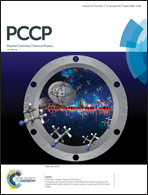Three-dimensional metal–organic framework derived porous CoP3 concave polyhedrons as superior bifunctional electrocatalysts for the evolution of hydrogen and oxygen†
Abstract
Developing low-cost and highly-efficient non-precious metal bifunctional electrocatalysts towards the hydrogen evolution reaction (HER) and oxygen evolution reaction (OER) is an attractively alternative strategy to solve the environmental pollution problems and energy demands. In this study, metal–organic framework (MOF) derived porous cobalt poly-phosphide (CoP3) concave polyhedrons are prepared and explored as superior bifunctional electrocatalysts for the HER and OER. The prepared MOF derived CoP3 concave polyhedrons show excellent electrocatalytic activity and stability towards the HER and OER in both acidic and alkaline media, with the Tafel slopes of 53 mV dec−1 and 76 mV dec−1 and a current density of 10 mA cm−2 at the overpotentials of −78 and 343 mV for the HER and OER, respectively, which are remarkably superior to those of the transition metal phosphides (TMPs) and comparable to those of the commercial precious metal catalysts. In addition, they also offer efficient catalytic activities and durabilities under neutral and basic conditions for the HER. The results of our study may shed light on the direction towards highly efficient bifunctional TMP electrocatalysts with high phosphorous component.



 Please wait while we load your content...
Please wait while we load your content...